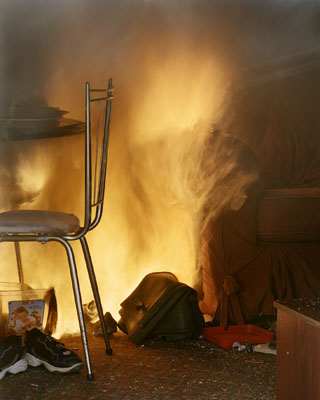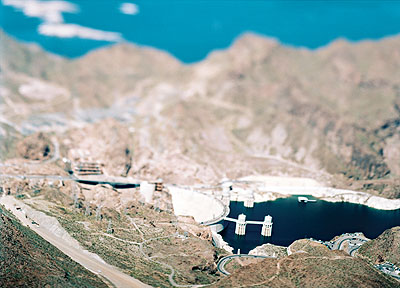
Abduction, 2007
C-Print
120 x 96 cm
Courtesy the artist and Meessen De Clercq, Brussels
Manipulating Reality
How Images Redefine the World
Adam Broomberg & Oliver Chanarin » Olivo Barbieri » Sonja Braas » Gregory Crewdson » Thomas Demand » Elena Dorfman » Christiane Feser » Beate Gütschow » Andreas Gefeller » Andreas Gursky » Tatjana Hallbaum » Ilkka Halso » Rosemary Laing » Aernout Mik » Saskia Olde Wolbers » Gwon Osang » Sarah Pickering » Moira Ricci » Cindy Sherman » Paolo Ventura » Melanie Wiora » & others
Exhibition: 25 Sep 2009 – 17 Jan 2010
Centro di Cultura Contemporanea Strozzina - CCCS
Piazza Strozzi
50123 Firenze
+39-055-2646560
Tue-Sun 10-20 , Thu -23

site specific_LAS VEGAS 05, 2005
Color print, 120 x 165 cm
Courtesy BRANCOLINI GRIMALDI ARTE CONTEMPORANEA, Roma
© Olivo Barbieri
In Manipulating Reality. How Images Redefine the World on view at the CCCS - Centro di Cultura Contemporanea Strozzina - Fondazione Palazzo Strozzi, Florence, from 25 September 2009 to 17 January 2010, 23 international artists will explore new ways of depicting reality with photographs and video-art which will reveal just how much, or how little, truth there is in what is seen and what is depicted. Under the directorship of Franziska Nori the concept for the exhibition resulted from a CCCS project which involved Brett Rogers (director of the Photographers' Gallery, London), Luminita Sabau (director of the DZ Bank Art Collection of contemporary photography, Frankfurt) and Martino Marangoni (director of the Fondazione Marangoni, Florence). The show will focus on the meaning of the term “reality” in the context of contemporary art as it explores the different ways of representing the world and the ambiguity that lies between the real and the verisimilar, the concrete and the apparent, the present and the past. Various disciplines have already signaled a paradigm shift when they contend that the “real world” does not exist as an independent category, merely as a projection or a construction by the individual. Actions and beliefs are then based on this “reality”. Photography and video art may not only record reality, they may, at the same time, falsify it. Today, with the spreading popularity of digital technology and the widespread dissemination of images through the mass media and the internet, this ambiguity has if anything increased, pushing the conflict between appearance and reality to its limits and demanding that the spectator play an active role in defining what he or she is seeing as real. The exhibition presents the work of 23 international artists: Olivo Barbieri (Italy), Sonja Braas (Germany), Adam Broomberg & Oliver Chanarin (South Africa), Gregory Crewdson (USA), Thomas Demand (Germany), Elena Dorfman (USA), Christiane Feser (Gremany), Andreas Gefeller (Germany), Andreas Gursky (Germany), Beate Gütschow (Germany), Tatjana Hallbaum (Germany), Ilkka Halso (Finland), Robin Hewlett & Ben Kinsley (USA), Rosemary Laing (Australia), Aernout Mik (The Netherlands), Saskia Olde Wolbers (The Netherlands), Gwon Osang (Korea), Sarah Pickering (UK), Moira Ricci (Italy), Cindy Sherman (USA), Cody Trepte (USA), Paolo Ventura (Italy) and Melanie Wiora (Germany). All use photography and video-art to manipulate our perception of the visible world and build new models of reality. The exhibition includes work by Cindy Sherman (USA, 1954), who conducts her exploration of the manipulation on her own body, transforming herself into affluent middle-aged women at the height of their social status and power yet feeling the onset of their physical decline. Despite the protective shield of their clothing, the camera and the spectator's gaze reveal them in all the crudeness of their naked reality. Andreas Gursky (Germany, 1955) juxtaposes and merges pictures of existing landscapes to create totally new and imaginary scenarios. Thomas Demand (Germany, 1964) creates the illusion of real spaces by photographing paper models constructed using pictures taken from the media. The same is true of Sonja Brass (Germany, 1968), who photographs miniature reconstructions of natural phenomena, such as the flow of lava or a tornado, highlighting their aesthetic and formal aspect and deceiving the viewer with the appearance of reality. Defining a new reality is an integral part of the philosophy underlying the work of Beate Gütschow (Germany, 1970), who uses a computer to reconstruct imaginary architecture; while for his part, Andreas Gefeller (Germany, 1970) forges impossible visions of ordinary spaces such as rooms, flats or places of work by resorting to the unusual juxtaposition of several different photographs taken from above. The human body, too, can be recomposed, as in the case of Gwon Osang (Korea, 1974) whose sculptures consist of hundreds of photographs mapping the entire surface area of his model. Reconstructing history or rethinking topical issues such as war, either as a direct critique or as part of a temporal and philosophical overlap, are some of the issues that characterize the work of other artists whose work is on display in the exhibition. The work of Paolo Ventura (Italy, 1968) focuses on the painful memory of the recent war in Iraq, reconstructing wartime scenarios using puppets and dummies dressed as soldiers. He uses ambiguity and the alteration of reality to comment on the real manipulation of “truth” in reports and pictures of the war carried in the media. Moira Ricci (Italy, 1979) inserts her own picture into portraits of her mother as a young woman, thus manipulating the past to build new memories of encounters that never took place. The exhibition is accompanied by a catalogue with contributions by James Der Derian (Watson Institute research professor of international studies and professor of political science at Brown University, USA), Harald Welzer (director of the Center for Interdisciplinary Memory Research, University of Essen, Germany), Elena Esposito (professor of Sociology and Communication Sciences at the University of Modena, Italy) and Maria Janina Vitale (art historian, with a specialization in contemporary photography).

Ohne Titel (Plattenbau 1) / Untitled (Panel Building 1), 2004
C-type print / Diasec
110 x 131 cm, Courtesy Thomas Rehbein Galerie, Köln
© Andreas Gefeller